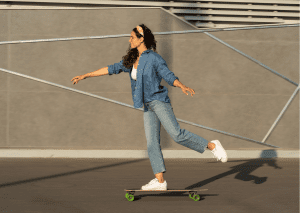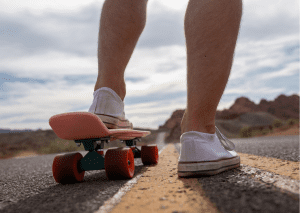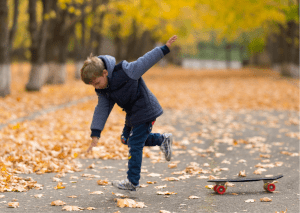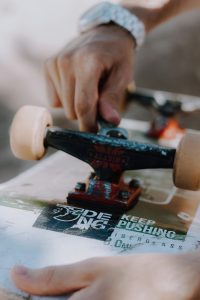What is safety skateboarding? Why is safety skateboarding important? Let’s talk about the safety of riders in off-road skateboarding. It is an exhilarating way to enjoy the great outdoors. However, doing this sport can pose risks in time if we’re not aware of the necessary precautions. We’ve put together a comprehensive list of safety riding tips and tricks to ensure you have a thrilling yet perfect and smooth ride. We hope that this will be your guide and it helps you to be protected against future accidents.

From understanding the basics of this adventurous multi-sport, such as the skateboard parts: trucks, wheels, bearings, and decks, to selecting the right off-road skateboard, mastering essential and basic off-road skills, learning how to fall safely even on uneven surfaces, and understanding local laws and regulations, every aspect contributes to a comprehensive approach to off-road skateboarding that prioritizes skateboarding safety features and skill development.
Not only that, but this article also guides you on how to choose the best helmet for a protected ride – same with riding a bike downhill, maintaining your top off-road skateboard properly for longevity, and ensuring optimal performance when riding boards. That’s a working order to avoid skateboarding injuries.
Key Takeaways
Off-road skateboarding is an exciting adventure for the rider that requires the right preparation and knowledge – it’s selecting the right off-road skateboard with attributes such as shape, size, and construction, gearing up with helmets, pads, and other protective gear or protective equipment, understanding local laws and regulations, and mastering the necessary techniques. This will enable you to avoid skateboarding injuries. Thus, the American Academy of Pediatrics suggests that for kids, adult supervision is required for first-time tricks.
Everyone knows that off-road skateboard riding is a thrilling adventure that builds agility, balance, coordination, and endurance. Learning how to fall safely without enduring a broken or cracked bone, and maintaining our skateboard in good condition is also crucial for us to enjoy this thrilling multi-sport without any worry. As enthusiasts, you can explore the wild terrain with full confidence and pride.
Off-Road Skateboard Basics
Before you tear up the trails, it’s crucial to grasp the basic skill of off-road skateboarding. This includes understanding the terrain, knowing where we can and can’t ride, and practicing off-road etiquette to preserve the environment and protect ourselves. Familiarize yourself with suitable locations or homes for off-road skateboarding, such as homemade ramps, supervised parks, and other designated riding areas, considering factors to stay focused like pedestrian traffic and tailoring your riding style to the specific conditions of the area. With these fundamentals, you and your fellow riders are ready to embark on a thrilling and safe adventure.
Right Off-Road Skateboard
Venturing into the wild on the wrong set of wheels could leave you in a world of hurt, so you must choose the right all-terrain board from your favorite skate shop for your adrenaline-fueled adventures on the road traffic.

It’s not just about picking any skateboard; customization and terrain considerations like wheel size, bearing type, and deck material play significant roles in ensuring off-road performance.
Skateboard Essential Safety Equipment
If you’re ready to take on the wild with your off-road skateboard, don’t forget: ride skateboarding safety is just as important as the fast ride itself!

Get to know some essential safety gear. Essential safety equipment includes a helmet, knee pad, elbow pad, and wrist guards, among others. Injuries happen, and if you wear a helmet and other comprehensive safety gear, it can minimize risks and prevent off-road injuries, ensuring a safer and more enjoyable experience during activities such as skateboarding. When selecting safety gear, wear a helmet and standard safety gear that meets or exceeds skateboarding safety standards set by organizations like the Consumer Product Safety Commission to provide enhanced safety and peace of mind.
Helmets
Let’s talk about the properly fitting helmet first, including the versatile multi-sport helmet. When it comes to headgear, modern designs provide enhanced safety, significantly lowering the risk of off-road skateboard injuries on daring trails. This particularly reduces the likelihood of head injury or brain injuries. The helmet fits snuggly, ensuring optimal coverage and safety. Additionally, it also mitigates the risk of facial injuries, especially in the presence of hard and sharp objects or when an accident happens like when you can get hit by a car. When selecting helmets, consider your preferences, such as choosing between a close full-face helmet for added facial protection or a half-face helmet, to tailor your essential protective equipment to your specific needs.
Protective Clothing
To wear riding safety equipment also means wearing safety clothing such as armored jackets and padded shorts to help minimize possible skateboarding injuries. You also need to wear slip-resistant shoes. Additionally, to improve safety and ensure a better grip, prioritize high-quality gloves.
Wrist Guards And Elbow And Knee Pads
Prioritize safety during off-road riding by wearing wrist guards, knee pads, and elbow pads. Wrist guards offer crucial support, reducing the risk of wrist injuries, including wrist fractures during falls or even when you get hit by a car. Knee pads protect against abrasions and more severe skateboarding injuries to the knees, ensuring a safer riding experience. Elbow pads reduce the risk of cuts, abrasions, and fractures in the elbow joint by acting as a cushion, providing essential protection during riding activities.
Together, these heavy-duty gear are essential for preventing skateboard injuries to key joints and vulnerable areas, allowing you to enjoy off-road skateboarding with confidence and peace of mind. However, in situations where wearing skateboarding safety gear is not possible or practical, it’s advisable to avoid off-road skateboarding.
Master Basic Techniques And Skills
Mastering basic techniques is crucial for ensuring an exhilarating yet safe journey on your board and mitigating the risks of getting hit by a car. Terrain adaptation teaches us to adjust our movement based on the ground’s condition such as its nicks and cracks, while trick execution helps us perform stunts smoothly and safely. Understanding these fundamentals not only enhances our personal off-road experience but also enables us to contribute to the safety and enjoyment of the thrill-seekers community, reducing the risk of serious skateboarding injuries.
Now, let’s shift gears and discuss one of the most important skills: learning how to fall safely. Riding skateboards is a dangerous sport, and it’s important to know how to properly fall to stop and reduce the risk of dangerous injury or any broken or cracked parts of the body. It’s also important to understand what to shop for new parts, how to use skateboarding safety gear, be aware of your surroundings, and look for somebody with whom you can hitch a ride if something untoward happens. Wear a helmet when riding, especially at higher speeds on-road riding and rough terrain so you will not deal with loose broken parts of your body. Follow skateboard safety tips for riding an electric skateboard, and consider visiting your local shop to find the best skateboard.
Learn How To Fall Securely With Protective Gear
Now, let’s tackle the art of falling – yes, there’s a right way to do it without dealing with cracked parts of the body’s bones, and it can make all the difference between a minor scrape and a serious injury on the road, especially when cruising at high speeds or navigating wet weather conditions with slippery top surface wheels. Falling techniques are key to injury prevention in riding, and mastering them can save you and others from harm. This is particularly crucial when riding off-road, where uneven terrain and unexpected obstacles can pose additional challenges. Whether you’re on the streets facing smooth pavements or venturing into off-road skateboarding with its uneven or irregular surfaces, honing your falling techniques is a crucial aspect of ensuring a safer and more enjoyable riding experience.

Practicing the proper falling technique is necessary to avoid cracked parts of the body, sharp pains, wounds on fleshy parts, and even brain or head injury. These can include tucking your body and rolling to minimize impact, is key to reducing the risk of serious injury and helping prevent gravel burns. Additionally, familiarizing yourself with other common practices, such as helmet and protective gear or protective equipment use, can help to ensure a fun and safe experience. Avoid the instinct to brace a fall with an outstretched arm, as this can lead to wrist injuries, and instead focus on rolling with the fall to disperse impact energy more effectively. Maintaining good balance is crucial; poor balance can increase the likelihood of falls and skateboarding injuries (such as loose broken or cracked bone parts , sharp and excruciating wounds), underscoring the importance of honing this skill for a safer experience.
Implementing these measures is essential in preventing many injuries and ensuring a safer and more enjoyable experience for off-road enthusiasts. In the event of an accident or possible emergencies, having basic knowledge of first aid and access to prompt medical assistance further contributes to the overall skateboarding safety and well-being of the community. Seeking prompt emergency medical care is crucial for addressing skateboarding injuries and promoting a swift recovery.
Overall Maintenance Tips
Everyone knows the importance of caring for your skateboard and the ride it offers. Here are some crucial tips on how to best maintain your off-road skateboard, ensuring it remains in optimal condition and minimizing the risk of serious defects. Whether you use your skateboard to perform tricks, navigate through traffic, or overcome other obstacles, proper maintenance is key to a safe and enjoyable riding experience.

Important Maintenance Tips For Riding Safely On Boards
- Master Skateboard Maintenance: Master the techniques of skateboard maintenance and repair to keep your off-road skateboard in peak condition. This includes knowing how to adjust the skateboard trucks, skateboard wheels, and skateboard bearings, as well as replacing worn-out grip tape and changing out broken skateboard parts to ensure safety.
- Skateboard Cleaning: Cleaning your off-road skateboard regularly is key to prolonging its lifespan and skateboard riding safety. Make sure to use non-abrasive cleaning products and soft cloths to avoid damaging the skateboard.
- Regular Skateboard Check-Up: To ensure skateboard safety, give your off-road skateboard regular check-ups to catch any potential problems before they become more serious. This includes checking the skateboard wheels and skateboard trucks for wear and tear and making sure the grip tape is still intact.
- Regular Skateboard Maintenance: This ensures that your off-road skateboard is in optimal condition, enhancing skateboard performance and your safety while skating off-road.
If you follow these tips, you can help ensure that your off-road skateboard will stay in great shape, whether you hit off-road skateboarding faster or engaging in various maneuvers. Taking good care of your skateboard is crucial for maintaining its optimal condition.
Conclusion
Off-road skateboarding is an exciting adventure that requires the right preparation and knowledge. It’s essential to select the right skateboard, gear up accordingly, and master the necessary techniques. Additionally, learning how to fall safely and maintaining our off-road skateboard in good condition is crucial. By following these safety guidelines, we can enjoy this thrilling sport without any worry.
As you take on this thrilling off-road adventure, let’s ensure that you have all of the good working and necessary equipment, knowledge, and safety precautions to make the most of your journey!
Wear the right safety gear and hit the off-road trails with level of confidence, understanding proper techniques, and following safety guidelines, all contributing to a secure and enjoyable off-road experience. Remember your safety throughout your journey, prioritizing precautionary measures to make the most of your thrilling off-road adventure.
Frequently Asked Questions (FAQs)
How To Ensure Safe Skateboarding?
To ensure skateboard safety while riding a skateboard, it’s crucial to not lose control. Always wear essential safety equipment such as helmets, knee pads, elbow pads, and wrist guards. Also, practicing in a controlled environment like a skate park can help riders control and learn proper techniques, including how to fall correctly.
Are Head Injuries Common In Skateboarding?
Head injuries are a concern in activities involving riding boards, including skateboarding and longboarding. While a head injury is not as common as some other types of injuries, it can be severe when they occur. Wearing a helmet is a crucial safety measure to reduce the risk of head injuries.
How Common Are Skateboarding Accidents?
Regarding injuries, skateboarding is in eighth place and appears to be less intimidating than commonly believed. Football, cycling, and basketball have the highest injury rates.
What’s The Most Common Skateboard Injury?
The most common injury is related to falls, resulting in sprains, fractures, and abrasions. Wrist injuries, particularly fractures and sprains, are prevalent among skateboarders who use their hands to break a fall. Additionally, injuries to the ankles, knees, and head are common. Skateboarders must wear protective gear or protective equipment , including helmets, knee pads, and elbow pads, to mitigate the risk of these injuries.
How Do Skaters Fall And Not Get Hurt?
Skaters can protect themselves from injuries by learning proper falling techniques and utilizing protective gear or protective equipment. Rolling out of falls, keeping knees bent, and avoiding overreaching are essential skate skills that help disperse impact forces and minimize the risk of injury. Skateboard safety gear such as helmets, knee pads, elbow pads, and wrist guards provide an additional layer of defense,
Is This A High-Risk Sport?
The risks include falls leading to injuries such as scrapes, bruises, sprains, fractures, or land on the fleshy broken nose. However, these risks can be mitigated by wearing the right good working order of equipment, using good technique, and practicing safe riding habits.
How To Prevent Ankle Injuries When Riding The Board?
Prevent ankle injuries while riding by maintaining proper foot placement, using supportive footwear, and gradually progressing in skill. Regularly inspect the riding surface for hazards, consider ankle braces for added support, and engage in strengthening exercises. Listening to your body and avoiding overexertion also contribute to a safer riding experience, minimizing the risk of ankle-related injuries.
What Are The Injuries In Skate Parks?
Injuries often encountered in skate parks encompass sprains, fractures, contusions, and abrasions arising from falls and collisions. Wrist injuries are frequent, given that skateboarders commonly use their hands to cushion falls. Ankle and knee injuries are also widespread due to the dynamic movements inherent in tricks. While less frequent, head injuries can be severe, underscoring the crucial importance of wearing helmets.
How To Prepare For Safety Skateboard Ride?
When riding a longboard, which is increasingly popular, skateboard safety can be maintained by wearing the correct protective gear and ensuring the longboard is in good condition. Beware of obstacles like rocks and gravel, and practice in safe, traffic-free zones. Understanding your speed limits and learning how to control your weight on the longboard is also crucial.
What To Avoid To Prioritize Safety When Riding?
To prioritize skateboard safety when riding, practice and avoid skipping essential gear or protective equipment, neglecting proper maintenance of your board, attempting advanced tricks without adequate skills, and riding in adverse weather conditions or on uneven terrain. Stay safe!
DISCLAIMER (IMPORTANT): This information (including all text, images, audio, or other formats on FamilyHype.com) is not intended to be a substitute for informed professional advice, diagnosis, endorsement or treatment. You should not take any action or avoid taking action without consulting a qualified professional. Always seek the advice of your physician or other qualified health provider with any questions about medical conditions. Do not disregard professional medical advice or delay seeking advice or treatment because of something you have read here a FamilyHype.com.